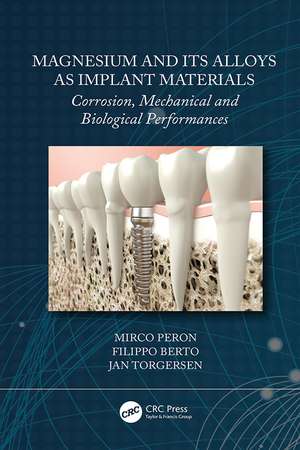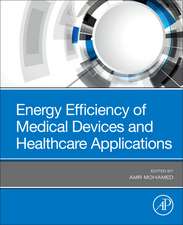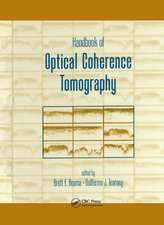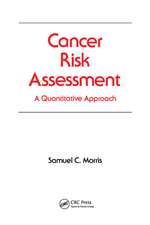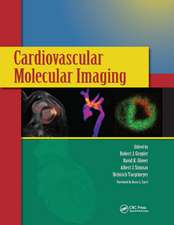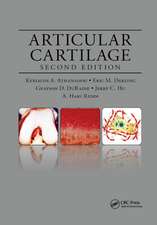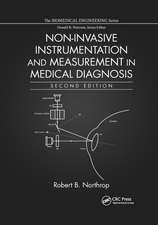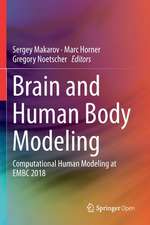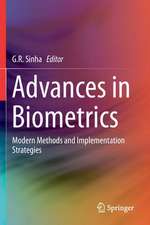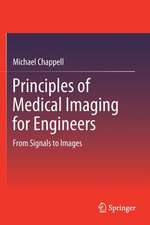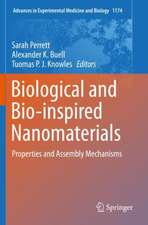Magnesium and Its Alloys as Implant Materials: Corrosion, Mechanical and Biological Performances
Autor Mirco Peron, Filippo Berto, Jan Torgersenen Limba Engleză Hardback – 7 apr 2020
| Toate formatele și edițiile | Preț | Express |
|---|---|---|
| Paperback (1) | 309.63 lei 6-8 săpt. | |
| CRC Press – 2 oct 2023 | 309.63 lei 6-8 săpt. | |
| Hardback (1) | 1109.21 lei 6-8 săpt. | |
| CRC Press – 7 apr 2020 | 1109.21 lei 6-8 săpt. |
Preț: 1109.21 lei
Preț vechi: 1352.69 lei
-18% Nou
Puncte Express: 1664
Preț estimativ în valută:
212.25€ • 226.97$ • 176.97£
212.25€ • 226.97$ • 176.97£
Carte tipărită la comandă
Livrare economică 17 aprilie-01 mai
Preluare comenzi: 021 569.72.76
Specificații
ISBN-13: 9780367429454
ISBN-10: 0367429454
Pagini: 194
Ilustrații: 30
Dimensiuni: 156 x 234 x 13 mm
Greutate: 0.45 kg
Ediția:1
Editura: CRC Press
Colecția CRC Press
ISBN-10: 0367429454
Pagini: 194
Ilustrații: 30
Dimensiuni: 156 x 234 x 13 mm
Greutate: 0.45 kg
Ediția:1
Editura: CRC Press
Colecția CRC Press
Cuprins
Contents
List of Abbreviations ........................................................................................ ix
Authors........................................................................................................... xiii
Chapter 1 Introduction................................................................................... 1
1.1 Introduction ...........................................................................1
References.......................................................................................4
Chapter 2 Challenges and Common Strategies ............................................... 9
2.1 Introduction ...........................................................................9
2.2 Corrosion Mitigation Strategies..............................................9
2.2.1 Impurities Removal.................................................. 10
2.2.2 Alloying ................................................................... 11
2.2.3 Grain Size Modification........................................... 11
2.3 Mechanical Properties Tuning .............................................. 14
2.3.1 Grain Refinement .................................................... 15
2.3.2 Solid Solution Strengthening ................................... 16
2.3.3 Precipitation Hardening........................................... 16
2.4 Interplay among Mechanical Properties, Corrosion
Resistance and Biocompatibility........................................... 17
References..................................................................................... 17
Chapter 3 Synopsis of Properties of Biocompatible Mg and Its Alloys......... 21
3.1 Introduction ......................................................................... 21
3.2 High-Pure Magnesium.......................................................... 21
3.2.1 High-Pure Magnesium: Mechanical Properties........ 21
3.2.2 High-Pure Magnesium: Corrosion Resistance.......... 23
3.2.3 High-Pure Magnesium: Biocompatibility................. 24
3.3 Aluminum-Based Alloys ....................................................... 26
3.3.1 AZ Alloys ................................................................ 28
3.3.1.1 AZ Alloys: Mechanical Properties ............. 28
3.3.1.2 AZ Alloys: Corrosion Resistance ............... 30
3.3.1.3 AZ Alloys: Biocompatibility ...................... 33
3.3.2 AM Alloys ............................................................... 33
3.3.2.1 AM Alloys: Mechanical Properties ............ 35
3.3.2.2 AM Alloys: Corrosion Resistance .............. 36
3.3.2.3 AM Alloys: Biocompatibility ..................... 39
3.3.3 Mg–Al–RE Alloys ................................................... 39
3.3.3.1 Mg–Al–RE Alloys: Mechanical
Properties ................................................... 40
3.3.3.2 Mg–Al–RE Alloys: Corrosion
Resistance .................................................. 42
3.3.3.3 Mg–Al–RE Alloys: Biocompatibility ......... 44
3.4 Mg–Zn Alloys....................................................................... 45
3.4.1 Mg–Zn Binary Alloys .............................................. 46
3.4.1.1 Mg–Zn Binary Alloys: Mechanical
Properties ................................................... 47
3.4.1.2 Mg–Zn Binary Alloys: Corrosion
Resistance .................................................. 47
3.4.1.3 Mg–Zn Binary Alloys: Biocompatibility .... 49
3.4.2 Mg–Zn–Zr Alloys .................................................... 53
3.4.2.1 Mg–Zn–Zr Alloys: Mechanical
Properties ................................................... 53
3.4.2.2 Mg–Zn–Zr Alloys: Corrosion
Resistance .................................................. 54
3.4.2.3 Mg–Zn–Zr Alloys: Biocompatibility .......... 59
3.4.3 Mg–Zn–Ca Alloys ................................................... 62
3.4.3.1 Mg–Zn–Ca Alloys: Mechanical
Properties ................................................... 63
3.4.3.2 Mg–Zn–Ca Alloys: Corrosion
Resistance .................................................. 66
3.4.3.3 Mg–Zn–Ca Alloys: Biocompatibility ......... 67
3.4.4 Mg–Zn–Ca BMGs................................................... 68
3.4.4.1 Mg–Zn–Ca BMGs: Mechanical
Properties ................................................... 70
3.4.4.2 Mg–Zn–Ca BMGs: Corrosion Resistance.. 71
3.4.4.3 Mg–Zn–Ca BMGs: Biocompatibility......... 72
3.4.5 Mg–Zn–Mn Alloys .................................................. 73
3.4.5.1 Mg–Zn–Mn Alloys: Mechanical
Properties ................................................... 75
3.4.5.2 Mg–Zn–Mn Alloys: Corrosion
Resistance .................................................. 78
3.4.5.3 Mg–Zn–Mn Alloys: Biocompatibility ........ 82
3.4.6 Mg–Zn–RE Alloys................................................... 83
3.4.6.1 Mg–Zn–RE Alloys: Mechanical
Properties ................................................... 86
3.4.6.2 Mg–Zn–RE Alloys: Corrosion
Resistance .................................................. 88
3.4.6.3 Mg–Zn–RE Alloys: Biocompatibility......... 91
3.5 Mg–Ca Alloys....................................................................... 91
3.5.1 Mg–Ca Alloys: Mechanical Properties..................... 92
3.5.2 Mg–Ca Alloys: Corrosion Resistance ...................... 98
3.5.3 Mg–Ca Alloys: Biocompatibility............................ 101
3.6 Mg–RE Alloys.................................................................... 102
3.6.1 Mg–RE Alloys: Mechanical Properties .................. 106
3.6.2 Mg–RE Alloys: Corrosion Resistance.................... 108
3.6.3 Mg–RE Alloys: Biocompatibility........................... 112
References................................................................................... 116
Chapter 4 Tackling the Challenges ............................................................. 145
4.1 Introduction ....................................................................... 145
4.2 Radar Chart: An Easy Tool to Compare Corrosion,
Mechanical and Biological Performances ........................... 145
Reference .................................................................................... 147
Chapter 5 Outlook...................................................................................... 149
Reference .................................................................................... 149
Appendix A: Corrosion ................................................................................... 151
Appendix B: In Vitro Biocompatibility Assessment ......................................... 161
Index.............................................................................................................. 165
List of Abbreviations ........................................................................................ ix
Authors........................................................................................................... xiii
Chapter 1 Introduction................................................................................... 1
1.1 Introduction ...........................................................................1
References.......................................................................................4
Chapter 2 Challenges and Common Strategies ............................................... 9
2.1 Introduction ...........................................................................9
2.2 Corrosion Mitigation Strategies..............................................9
2.2.1 Impurities Removal.................................................. 10
2.2.2 Alloying ................................................................... 11
2.2.3 Grain Size Modification........................................... 11
2.3 Mechanical Properties Tuning .............................................. 14
2.3.1 Grain Refinement .................................................... 15
2.3.2 Solid Solution Strengthening ................................... 16
2.3.3 Precipitation Hardening........................................... 16
2.4 Interplay among Mechanical Properties, Corrosion
Resistance and Biocompatibility........................................... 17
References..................................................................................... 17
Chapter 3 Synopsis of Properties of Biocompatible Mg and Its Alloys......... 21
3.1 Introduction ......................................................................... 21
3.2 High-Pure Magnesium.......................................................... 21
3.2.1 High-Pure Magnesium: Mechanical Properties........ 21
3.2.2 High-Pure Magnesium: Corrosion Resistance.......... 23
3.2.3 High-Pure Magnesium: Biocompatibility................. 24
3.3 Aluminum-Based Alloys ....................................................... 26
3.3.1 AZ Alloys ................................................................ 28
3.3.1.1 AZ Alloys: Mechanical Properties ............. 28
3.3.1.2 AZ Alloys: Corrosion Resistance ............... 30
3.3.1.3 AZ Alloys: Biocompatibility ...................... 33
3.3.2 AM Alloys ............................................................... 33
3.3.2.1 AM Alloys: Mechanical Properties ............ 35
3.3.2.2 AM Alloys: Corrosion Resistance .............. 36
3.3.2.3 AM Alloys: Biocompatibility ..................... 39
3.3.3 Mg–Al–RE Alloys ................................................... 39
3.3.3.1 Mg–Al–RE Alloys: Mechanical
Properties ................................................... 40
3.3.3.2 Mg–Al–RE Alloys: Corrosion
Resistance .................................................. 42
3.3.3.3 Mg–Al–RE Alloys: Biocompatibility ......... 44
3.4 Mg–Zn Alloys....................................................................... 45
3.4.1 Mg–Zn Binary Alloys .............................................. 46
3.4.1.1 Mg–Zn Binary Alloys: Mechanical
Properties ................................................... 47
3.4.1.2 Mg–Zn Binary Alloys: Corrosion
Resistance .................................................. 47
3.4.1.3 Mg–Zn Binary Alloys: Biocompatibility .... 49
3.4.2 Mg–Zn–Zr Alloys .................................................... 53
3.4.2.1 Mg–Zn–Zr Alloys: Mechanical
Properties ................................................... 53
3.4.2.2 Mg–Zn–Zr Alloys: Corrosion
Resistance .................................................. 54
3.4.2.3 Mg–Zn–Zr Alloys: Biocompatibility .......... 59
3.4.3 Mg–Zn–Ca Alloys ................................................... 62
3.4.3.1 Mg–Zn–Ca Alloys: Mechanical
Properties ................................................... 63
3.4.3.2 Mg–Zn–Ca Alloys: Corrosion
Resistance .................................................. 66
3.4.3.3 Mg–Zn–Ca Alloys: Biocompatibility ......... 67
3.4.4 Mg–Zn–Ca BMGs................................................... 68
3.4.4.1 Mg–Zn–Ca BMGs: Mechanical
Properties ................................................... 70
3.4.4.2 Mg–Zn–Ca BMGs: Corrosion Resistance.. 71
3.4.4.3 Mg–Zn–Ca BMGs: Biocompatibility......... 72
3.4.5 Mg–Zn–Mn Alloys .................................................. 73
3.4.5.1 Mg–Zn–Mn Alloys: Mechanical
Properties ................................................... 75
3.4.5.2 Mg–Zn–Mn Alloys: Corrosion
Resistance .................................................. 78
3.4.5.3 Mg–Zn–Mn Alloys: Biocompatibility ........ 82
3.4.6 Mg–Zn–RE Alloys................................................... 83
3.4.6.1 Mg–Zn–RE Alloys: Mechanical
Properties ................................................... 86
3.4.6.2 Mg–Zn–RE Alloys: Corrosion
Resistance .................................................. 88
3.4.6.3 Mg–Zn–RE Alloys: Biocompatibility......... 91
3.5 Mg–Ca Alloys....................................................................... 91
3.5.1 Mg–Ca Alloys: Mechanical Properties..................... 92
3.5.2 Mg–Ca Alloys: Corrosion Resistance ...................... 98
3.5.3 Mg–Ca Alloys: Biocompatibility............................ 101
3.6 Mg–RE Alloys.................................................................... 102
3.6.1 Mg–RE Alloys: Mechanical Properties .................. 106
3.6.2 Mg–RE Alloys: Corrosion Resistance.................... 108
3.6.3 Mg–RE Alloys: Biocompatibility........................... 112
References................................................................................... 116
Chapter 4 Tackling the Challenges ............................................................. 145
4.1 Introduction ....................................................................... 145
4.2 Radar Chart: An Easy Tool to Compare Corrosion,
Mechanical and Biological Performances ........................... 145
Reference .................................................................................... 147
Chapter 5 Outlook...................................................................................... 149
Reference .................................................................................... 149
Appendix A: Corrosion ................................................................................... 151
Appendix B: In Vitro Biocompatibility Assessment ......................................... 161
Index.............................................................................................................. 165
Notă biografică
Mirco Peron earned his degree in mechanical engineering (summa cum laude)
in 2015 from the University of Padova, where his thesis evaluated the fatigue
damage and stiffness evolution in composite laminates. He is currently a PhD
student at Norwegian University of Science and Technology (NTNU), Trondheim.
His PhD topic deals with the optimization of mechanical and corrosion
properties of magnesium and its alloys for biomedical applications, with particular
reference to the corrosion-assisted cracking phenomena.
Filippo Berto is Chair of Structural Integrity at the Norwegian University of
Science and Technology in Norway. He is in charge of the Mechanical and
Material Characterization Lab in the Department of Mechanical and Industrial
Engineering. He is author of more than 500 technical papers, mainly
oriented to materials science engineering, the brittle failure of different materials,
notch effect, the application of the finite element method to the structural
analysis, the mechanical behavior of metallic materials, the fatigue performance
of notched components as well as the reliability of welded, bolted and
bonded joints. Since 2003, he has been working on different aspects of the
structural integrity discipline, by mainly focusing attention on problems
related to the static and fatigue assessment of engineering materials with particular
attention to biomedical and medical applications and materials.
Jan Torgersen is Professor of mechanical engineering at NTNU, Trondheim.
He received his PhD from Vienna University of Technology, where he worked
on high-resolution laser microfabrication of hydrogels for tissue engineering.
He was pioneering in the work of processing hydrogel formulations at micron
scale resolution in vivo, in the presence of living cells and whole organisms.
He received a postdoctoral fellowship to work on a nanoscale vapor deposition
technique called atomic layer deposition, allowing conformal coating of
thermally fragile and nanostructured substrates with atomically thin layers of
a wide range of materials. He contributed to the development of a selflimiting
deposition process for high-k materials for Dynamic Random Access
Memory (DRAM) applications. His current research interests are micro- and
nanofabrication as well as surface functionalization, with particular focus on
biomedical applications.
in 2015 from the University of Padova, where his thesis evaluated the fatigue
damage and stiffness evolution in composite laminates. He is currently a PhD
student at Norwegian University of Science and Technology (NTNU), Trondheim.
His PhD topic deals with the optimization of mechanical and corrosion
properties of magnesium and its alloys for biomedical applications, with particular
reference to the corrosion-assisted cracking phenomena.
Filippo Berto is Chair of Structural Integrity at the Norwegian University of
Science and Technology in Norway. He is in charge of the Mechanical and
Material Characterization Lab in the Department of Mechanical and Industrial
Engineering. He is author of more than 500 technical papers, mainly
oriented to materials science engineering, the brittle failure of different materials,
notch effect, the application of the finite element method to the structural
analysis, the mechanical behavior of metallic materials, the fatigue performance
of notched components as well as the reliability of welded, bolted and
bonded joints. Since 2003, he has been working on different aspects of the
structural integrity discipline, by mainly focusing attention on problems
related to the static and fatigue assessment of engineering materials with particular
attention to biomedical and medical applications and materials.
Jan Torgersen is Professor of mechanical engineering at NTNU, Trondheim.
He received his PhD from Vienna University of Technology, where he worked
on high-resolution laser microfabrication of hydrogels for tissue engineering.
He was pioneering in the work of processing hydrogel formulations at micron
scale resolution in vivo, in the presence of living cells and whole organisms.
He received a postdoctoral fellowship to work on a nanoscale vapor deposition
technique called atomic layer deposition, allowing conformal coating of
thermally fragile and nanostructured substrates with atomically thin layers of
a wide range of materials. He contributed to the development of a selflimiting
deposition process for high-k materials for Dynamic Random Access
Memory (DRAM) applications. His current research interests are micro- and
nanofabrication as well as surface functionalization, with particular focus on
biomedical applications.
Descriere
Despite their tremendous potential, Mg and its alloys are not yet used in biomedical applications. This book aims to provide scientific insights into the challenges of the materials, and give an overview of the research regarding the mechanical properties, corrosion behaviour and biological performances of these materials.
